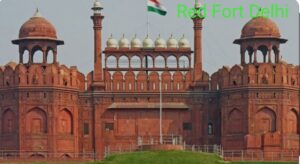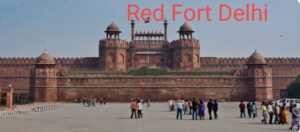The Red Fort Delhi, also known as Lal Qila, is an iconic symbol of India’s rich history and cultural heritage. Located in the heart of Delhi, this magnificent fortress stands as a testament to the architectural brilliance of the Mughal era. Built by Emperor Shah Jahan in the 17th century, the Red Fort has witnessed the rise and fall of empires and has played a crucial role in shaping the history of India. Today, it is not only a major tourist attraction but also a symbol of national pride, hosting the annual Independence Day celebrations.

1. Red Fort Delhi: Historical Background
The construction of the Red Fort began in 1638 under the orders of Emperor Shah Jahan, who is also known for building the Taj Mahal. The fort was completed in 1648 and served as the main residence of the Mughal emperors for nearly 200 years. Shah Jahan moved his capital from Agra to Delhi, and the Red Fort became the political and cultural center of the Mughal Empire.
Inspired by Persian, Timurid, and Indian architectural styles, the Red Fort is a masterpiece of design and craftsmanship. The fort’s red sandstone walls stretch for over two kilometers, enclosing a complex of palaces, halls, and gardens that reflect the grandeur and opulence of the Mughal court.
2. Red Fort Delhi: Architectural Marvel
The Red Fort is an architectural marvel that showcases the finest examples of Mughal art and design. The fort is divided into several key structures, each with its unique charm and significance.
– Diwan-i-Aam (Hall of Public Audience): This hall was used by the emperor to address the general public and listen to their grievances. The hall is adorned with intricate marble work and features a throne balcony where the emperor would sit.
– Diwan-i-Khas (Hall of Private Audience): This was a more intimate hall where the emperor would meet with his courtiers and foreign dignitaries. The hall is famous for its stunning peacock throne and delicate marble inlays.
– Rang Mahal (Palace of Colors) : The Rang Mahal was the residence of the emperor’s wives and mistresses. It is known for its beautiful floral decorations, fountains, and water channels that kept the palace cool during the hot summer months.
– Mumtaz Mahal : Named after Shah Jahan’s beloved wife, Mumtaz Mahal, this palace was used as a private residence. It now houses a museum displaying artifacts from the Mughal era.
– Lahore Gate : The main entrance to the fort, the Lahore Gate is an imposing structure that leads to a bustling bazaar called Chatta Chowk, where artisans and craftsmen sell their wares.
The fort’s unique features, such as its marble inlays, intricate carvings, and lush gardens, make it a true architectural wonder. The use of water channels and fountains throughout the complex highlights the Mughals’ advanced knowledge of engineering and aesthetics.

3.Red Fort Delhi : Red Fort in Modern History
The Red Fort has played a significant role in India’s modern history as well. During the Indian Rebellion of 1857, the fort became a symbol of resistance against British rule. After the rebellion, the British used the fort as a military base and a prison.
The most notable moment in the fort’s modern history came on August 15, 1947, when India’s first Prime Minister, Jawaharlal Nehru, hoisted the national flag from the ramparts of the Red Fort, marking the end of British colonial rule. This tradition continues to this day, with the Prime Minister addressing the nation from the fort on Independence Day every year.
Preservation and restoration efforts have been ongoing to maintain the fort’s grandeur. The Archaeological Survey of India (ASI) has undertaken various initiatives to preserve the historical integrity of the site while allowing visitors to experience its beauty.
4. Red Fort Delhi: Tourist Attraction
The Red Fort is a major tourist attraction, drawing visitors from around the world. Here are some of the highlights and tips for visiting:
– What to See and Do : Explore the various palaces, halls, and gardens within the fort. Don’t miss the evening sound and light show that narrates the history of the Red Fort and the Mughal Empire.
– Best Times to Visit : The best time to visit the Red Fort is during the cooler months, from October to March. The fort is open to visitors every day except Mondays.
– Tips for Visitors : Wear comfortable shoes as there is a lot of walking involved. Carry water and a hat to protect yourself from the sun. Hire a guide or use an audio guide to get a deeper understanding of the fort’s history and architecture.
5.Cultural and Social Significance
The Red Fort is not just a historical monument; it is also a cultural hub. The fort hosts various festivals and events throughout the year, such as the Independence Day celebrations, the annual Dussehra festival, and cultural programs showcasing Indian art, music, and dance.
The fort has inspired numerous artists, writers, and filmmakers, becoming a symbol of India’s rich cultural heritage. Its grandeur and beauty have been depicted in various works of art, literature, and cinema, further cementing its place in the hearts and minds of people around the world.
6.Practical Information
– Location and Accessibility : The Red Fort is located in the old city of Delhi, near the Yamuna River. It is easily accessible by metro, bus, and taxi. The nearest metro station is Chandni Chowk.
– Ticket Information and Timings : Tickets can be purchased at the entrance or online. The fort is open from 9:30 AM to 4:30 PM, and entry is free for children under 15 years.
– Nearby Attractions : While visiting the Red Fort, you can also explore nearby attractions such as Jama Masjid, Chandni Chowk, and Raj Ghat.
Conclusion:
The Red Fort is a living testament to India’s glorious past and a beacon of its cultural and historical legacy. Whether you are a history enthusiast, an architecture aficionado, or simply a curious traveler, the Red Fort offers a captivating journey through time. Plan your visit and immerse yourself in the rich tapestry of India’s heritage that this magnificent fortress so beautifully encapsulates.
FAQ:
1.What is special about the Red Fort in Delhi?
2.What is the ticket price of Red Fort?
3.Who built the Red Fort?
4.Red fort delhi timings
5.Red fort delhi ticket price
6.Red Fort history

